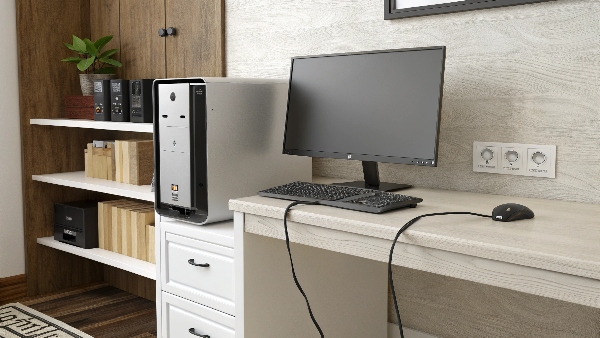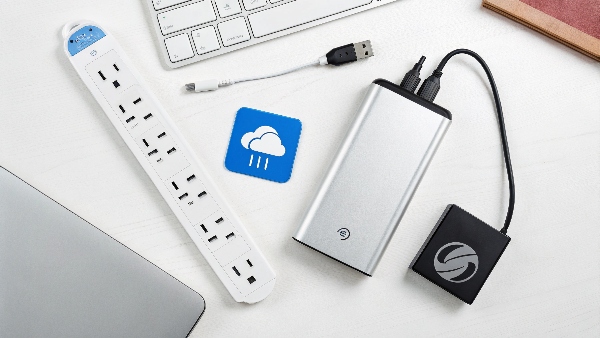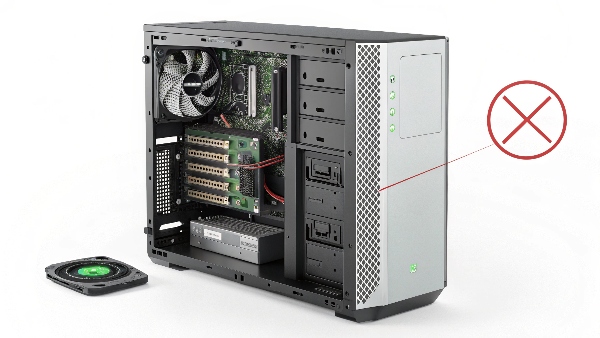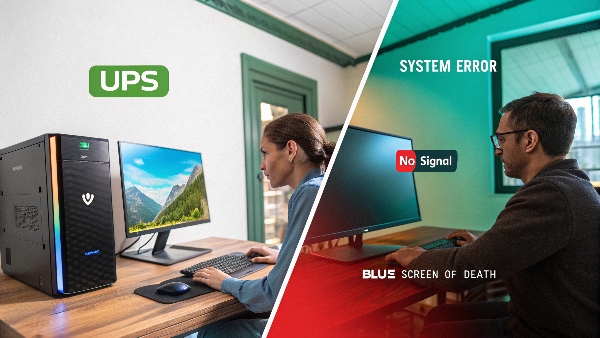Running your desktop without a UPS and worried about what might happen during a power flicker or surge? This unprotected state can lead to data loss, hardware damage, and significant frustration.
If you don't have a UPS, immediately start saving work frequently, use a quality surge protector as a bare minimum, and seriously consider investing in a UPS soon for complete protection.

It's a common situation to find yourself in, perhaps you've just set up a new PC or haven't gotten around to buying a UPS yet. As someone who has spent 10 years at DAOPULSE designing and manufacturing uninterruptible power supplies, I understand the importance of stable power. While the ideal solution is always a UPS, especially for desktop computers that lack an internal battery, there are interim steps you can take and risks you should understand. We'll explore what happens without one, what alternatives exist, and why a UPS is such a vital component for any desktop setup, protecting your data and hardware investment.
Is it OK to use desktop without UPS?
You're using your desktop daily, and things seem fine, so is skipping a UPS really a big deal? This gamble might seem okay now, but a sudden power issue could instantly change that perspective.
You can technically use a desktop without a UPS, but it's not advisable. Doing so exposes your system to risks like data corruption, hardware damage from power surges or sags, and lost productivity.

While your desktop will function without a UPS, you're essentially operating without a safety net. Think of it like driving a car without insurance; you might be fine for a while, but one incident can be costly. The primary issue is that desktops, unlike laptops, have no internal battery. So, the moment mains power is interrupted or significantly fluctuates, your system shuts down abruptly.
This can lead to several problems:
- Data Loss and Corruption: If you're working on an important document, spreadsheet, or creative project and the power cuts, any unsaved changes are instantly gone. Worse, if the power fails while the operating system or an application is writing to the disk, files can become corrupted. This could even affect critical system files, potentially rendering your PC unbootable. I recall a time, early in my career before I fully appreciated the intricacies of power protection, when I lost several hours of coding work due to a brief power flicker – it was a painful lesson.
- Hardware Damage: Power surges, which can be caused by lightning strikes (even distant ones), utility grid switching, or faulty appliances in your building, can send a damaging jolt of electricity through your components. Your PC's power supply unit (PSU) offers some protection, but a strong surge can overwhelm it and fry sensitive parts like the motherboard, CPU, GPU, or storage drives. Sags (brownouts) can also stress components.
- Reduced Component Lifespan: Even if a power event doesn't cause immediate failure, repeated exposure to "dirty" power (fluctuations, noise) and hard shutdowns can stress electronic components over time, potentially shortening their operational life.
At DAOPULSE, we design UPS systems precisely to mitigate these risks. Our clients, like Mr. Li, a Procurement Manager for hospital infrastructure, understand that critical systems cannot afford such vulnerabilities. While a home desktop might not be life-critical, the data and hardware are certainly valuable to you.
What to use instead of UPS?
No UPS for your desktop right now, but you're anxious about power problems? You're looking for alternatives that can offer at least some level of protection without the immediate investment in a UPS.
While no direct substitute offers full UPS benefits, use a high-quality surge protector for spike defense. Implement rigorous backup routines (local and cloud) and consider a portable power station for manual backup power.

If a UPS isn't an option for you at this very moment, there are a few measures you can take to reduce, though not eliminate, the risks. It's crucial to understand that these are not full replacements for the comprehensive protection a UPS provides.
- Surge Protector: This is the absolute bare minimum. A good quality surge protector will guard your equipment against voltage spikes. Look for one with a high joule rating (higher is better, indicating it can absorb more energy) and ideally an indicator light to show it's still functional. However, a surge protector does nothing for power sags, brownouts, or blackouts (complete power loss). It won't keep your PC running. It's a shield against one specific threat, not comprehensive armor.
- Frequent Manual Saves and Auto-Save Features: Cultivate the habit of pressing Ctrl+S (or Cmd+S on Mac) constantly. Enable auto-save features in your applications (like Microsoft Office, Google Docs) and set them to save frequently.
- Systematic Backups: This is vital regardless of whether you have a UPS.
- Local Backups: Use built-in operating system tools like Windows File History or macOS Time Machine with an external hard drive. Schedule regular backups.
- Cloud Backups: For your most critical files, use cloud storage services like OneDrive, Google Drive, Dropbox, or specialized backup services. This protects against local disasters too. At DAOPULSE, we emphasize data redundancy for all our important project files and client communications.
- Portable Power Station (PPS): These devices are essentially large batteries with AC outlets. They can power a desktop, but they are not a UPS. A PPS does not offer the instantaneous, automatic switchover to battery power that a UPS does. If the power goes out, your PC will still shut down. You would then need to manually plug your PC into the PPS and reboot. It's useful for extended outages if you can manage the manual intervention, but it won't save you from flickers or provide line conditioning.
Here’s a quick comparison:
| Feature | Surge Protector | Frequent Saves & Backups | Portable Power Station | True UPS |
|---|---|---|---|---|
| Surge Protection | Yes | No | Some models may have | Yes (often better) |
| Outage Protection | No | No | Yes (manual switch) | Yes (automatic) |
| Brownout/Sag Ride-Thru | No | No | No (PC still reboots) | Yes (AVR models) |
| Data Loss Prevention | Partial (surge) | Yes (if saved/backed up) | Low (PC reboots) | High |
| Cost | Low | Varies (drive/service) | Medium to High | Medium |
While these steps help, my strong recommendation, based on a decade in this industry, is to prioritize getting a proper UPS.
Do desktops need UPS?
You might be thinking, "My phone and laptop have batteries, so they're fine. Is a UPS really a must-have for my desktop, or just an optional extra?"
Yes, desktops absolutely need a UPS, arguably more so than portable devices. Unlike laptops with built-in batteries, desktops are immediately vulnerable to any power interruption, risking data, hardware, and productivity.

The simple answer is a resounding yes. Desktops, by their very nature, are stationary and rely entirely on a continuous supply of mains power. Here’s why they particularly benefit from, and frankly need, UPS protection:
- No Internal Battery: This is the most critical difference compared to a laptop. A laptop's battery acts as a built-in UPS, seamlessly taking over if the power cord is unplugged or if there's a power cut. A desktop has no such luxury. The instant power is lost or drops too low, the system shuts off hard.
- Sensitivity of Components: Desktop computers often house powerful and sensitive components: multi-core CPUs, high-end graphics cards, multiple RAM modules, and spinning hard disk drives (HDDs) or solid-state drives (SSDs). HDDs are particularly vulnerable if power is cut during a read/write operation, which can lead to bad sectors or even head crashes. Sudden power loss can also stress SSD controllers and other delicate circuitry on the motherboard.
- Critical Data and Workloads: Desktops are frequently used for more intensive tasks, longer projects, gaming sessions, or storing significant amounts of important data. An unexpected shutdown can mean the loss of hours of work, corruption of large project files, or interruption of critical processes. Our clients in industries like finance and healthcare rely on our UPS systems, including advanced lithium battery UPS solutions, to protect workstations running critical applications. The principle of safeguarding valuable work and data integrity applies equally to a personal desktop.
- Operating System Stability: An abrupt power off can corrupt operating system files. This can lead to annoying glitches, failure of certain programs to run, or even prevent your computer from booting up altogether. Reinstalling an OS and all your applications is a time-consuming and frustrating process.
My core insight, and a guiding principle at DAOPULSE, is that for data security and hardware longevity, any computer that processes or stores valuable information warrants the protection of an uninterruptible power supply. This isn't just for mission-critical servers; it's for your desktop too.
What happens if I don't use UPS?
You're weighing the cost of a UPS against the potential risks of not having one. What are the actual, tangible consequences you might face if you decide to run your desktop unprotected?
Without a UPS, you directly risk frequent data corruption or total loss, premature hardware failure from power surges or sags, a decreased lifespan for PC components, and many frustrating interruptions leading to lost time and productivity.

Choosing to operate a desktop without a UPS is choosing to accept a range of potential negative outcomes. These aren't just theoretical possibilities; they are real-world problems that people encounter regularly. Here's a summary of what can, and often does, happen:
- Data Loss:
- Unsaved Work Vanishes: The most immediate and common issue. Hours of writing, coding, designing, or gaming progress can be wiped out in an instant by a power flicker.
- File Corruption: If the power goes out while a file is being saved or your operating system is writing to the disk, that file (or even system files) can become corrupted and unusable. Trying to recover corrupted data can be difficult or impossible.
- Hardware Damage:
- Surge Damage: A power surge can fry your motherboard, power supply unit (PSU), graphics card, or other sensitive components. This often means expensive repairs or replacements.
- Brownout/Sag Stress: Low voltage conditions force your PSU to work harder and can stress components, potentially leading to premature failure. Hard disk drives are particularly susceptible to damage from sudden power loss while active.
- Reduced Component Lifespan: Even if your components don't fail outright after a power event, the cumulative stress from repeated hard shutdowns and "dirty" power can shorten their overall lifespan. It’s like constantly slamming on your car’s brakes instead of smoothly decelerating; things wear out faster.
- Wasted Time and Increased Frustration:
- Rebooting and Reloading: Every unexpected shutdown means time lost rebooting, reopening applications, and trying to get back to where you were.
- Troubleshooting: If file corruption or hardware issues occur, you'll spend additional time diagnosing problems, running repair utilities, or seeking technical help. I've spoken with many system integrators who tell stories of clients trying to save a small amount by skipping a UPS, only to face much larger costs in data recovery services, replacement parts, and significant operational downtime.
- Loss of Productivity: All of the above translates directly into lost productivity and increased stress.
At DAOPULSE, our entire business is built around preventing these exact scenarios for our clients, from global brands to individual users. Our commitment to quality, evidenced by CE, RoHS, and ISO certifications, ensures our UPS systems provide reliable protection against these damaging events.
Conclusion
Using a desktop without a UPS risks data, hardware, and time. While interim steps help, a UPS is the best defense, ensuring your system's safety and your peace of mind.

